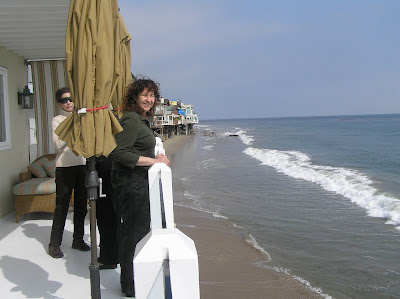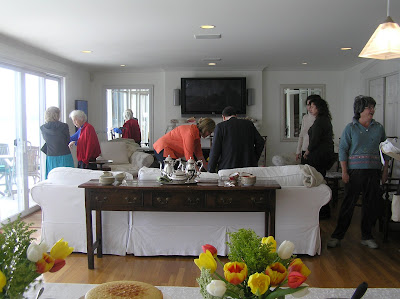

Spring in Santa Monica


As Jane Austen's popularity explodes out of all propriety, I wish I could learn to like the changes that are occurring in the greater Jane Austen universe. But what was once a cozy community of people who shared an enthusiasm, has become a worldwide mass culture industry, and I feel much as I do about the disappearance of small secondhand bookshops: like a small, aging person being trodden over by a machine. Perhaps what I need is someone to preach patience and resignation to me, as Anne did to Captain Benwick in Persuasion.
No, this is not a cry out against the zombie and vampire books, or the thousand and one stunningly un-Scheherazade-like clunky sequels. It's hardly for me to object to them. After all, I was an early participant in the phenomenon - my Mrs. Darcy's Dilemma was written in 1994, and I believe was the first Pride and Prejudice sequel since the 1940s, and I've played with pastiche and committed continuations to my heart's delight, ever since. Nor is my conscience completely easy on the vampire front. Noticing several years ago that vampire novels and Austen-related books were selling gigantically, it occurred to me to pair the two, in the firm belief that connecting Transylvania and Chawton would be the way to massive best sellerdom. Unfortunately for my bank account, much as I tinkered with the idea, it never took hold, the way a book does when it's going well. My Achilles heel was the sucking of blood. I could not write vampire scenes to save my life. So I resigned myself to the knowledge that inevitably somebody else would come up with the Vampire Jane formula and make their fortune, but it wouldn't be me. And in the event, that is exactly what happened. Whoever-it-is that did it got a million dollar deal. Fair enough: if you can't make vampires come to life, no paycheck. So it's not the squalid sequels and supernatural spin-offs that really disturb me (though I must say that the cover art for Pride and Prejudice and Zombies does make me literally lurchingly sick to my stomach). No, it's the wholesale changes in the Austen world itself in the last few years, that make me sicker than even the picture of poor Austen with her teeth rotting in her bared skull. (To refresh ourselves after the sickening image, let us turn to momentarily to a soothing rather than a distressing sight: a picture of Pindar, in her nine-month-old, adolescent kitten beauty.)
Pindar, Pindy, Miss Pin, a Picture of Perfection

What are these changes in the Austen universe, and why do they pain me so? First, there is the massive spate of Austen films that have introduced millions of people to her works that never read her before. In some kind of antifeminist crucifixion, like Aslan patiently enduring torture by the evil beasts, she has been hoisted into media superstar status. It's true that universal admiration is no more than she deserves, because there is no more wonderful writer. But popular culture, in playing to the lowest common denominator, distorts and defaces the beloved object. Jane Austen is literally being loved to death, but what the masses are insensately loving, isn't her. The zombiefication of Jane is only a cheerful quirky joke. What saddens me is her not being appreciated and understood as she should be, her work being taken for something it is not. She herself is beyond caring, and most will think that commercial exploitation does no harm if it spreads the word that she is worth reading. Perhaps she should not be kept only as an elixir for the elite, but it is painful to me nonetheless to see her defaced and spread out over the English speaking world like a grotesque plasticine puppet. I confess to wishing that she could be rolled up and stuffed back into a little bit of ivory.
Jane Austen's brilliant writing, with its Johnsonian balance of prose, its endless subtle witticisms and meanings, its unsparing dark humor concealed under decorum, is no banal celluloid romance fiction. Few writers can be re-read so often, not dozens, but hundreds and thousands of times, with a new beauty, a new shade of meaning, a new foreshadowing, a new private ghostly laugh, being revealed every time. Only Shakespeare compares, and Shakespeare, though interpreted in thousands of different ways, has not been mutilated and traduced to this extent, with quite this rapine degree of glee, with vultures falling on the victim, triumphantly holding up and auctioning the gizzard. Perhaps Shakespeare's shade gets more respect, as a male shade. Perhaps it's because the framework of each of Austen's novels is that of a happy ending love story, and the majority of the present generation of filmgoers and sequel-readers take her for a romantic novelist, remaining unaware of the riches and complexity that lie beneath the surface, and take a lifetime of reading to discover. My palpitations at this point require smelling-salts: let us turn to Pindar in another glamorous pose. Does she not bring to mind the young Marilyn Monroe, nude on red crumpled silk?
The Marilyn Monroe Pose

Perhaps I am simply mad. Who else but a madwoman reads Jane Austen over and over for a whole lifetime, and thinks every one of the films (with a grudging nod for the Emma Thompson Sense and Sensibility) is a misshapen child that would better have been smothered in the screenplay stage? It's a contrarian, minority, curmudgeonly, peculiarly sour, point of view. But I will defend my opinion until the moment when like my idol and mentor, I arrive at the point of asking for "Nothing but death." I will go down reading. Still, I don't have to buy anyone else's sequels (I don't), or go to any more of the films (never again). Why, oh why, does the popularization of Jane Austen disturb me so? Is it because she was all about the fitness of things, and the wholesale gross distortion of her work is so patently unfit?
"Two offences of a very different nature, and by no means of equal magnitude, you last night laid to my charge."
I will present two exhibits, which together give something of the flavor of the Austen universe today, and what it has become. The anecdotes come from widely different quarters, but cover the spectrum.
The Madness of Scholars

In the April 24 edition of the Times Literary Supplement, the Australian academic Jocelyn Harris did a fairly comprehensive bashing of the last book in the Cambridge Edition of the Complete Works of Jane Austen, Jane Austen's Later Manuscripts, edited by Janet Todd and Linda Bree. It had the look of a hatchet job, making the reader wonder if there was a motive behind. Generally, with such a distinguished work of scholarship as the Cambridge Edition, a scholarly reviewer might cavil on some points, or argue the pros and cons of the publication of another edition of Jane Austen. So this review was mean spirited enough to raise suspicions. The answer was not far to seek, for the open secret in Austen academic publishing, is (as Mr. Weston said about Emma's marriage, "These matters are always a secret, till it is found out that every body knows them") that Jocelyn Harris was originally hired to edit one of the volumes of the Cambridge Edition herself, and was subsequently asked to withdraw because her work was not up to par. She was one of two editors who had to be let go during the long and arduous process of assembling this ambitious work. In their response to Harris's review, the editors Janet Todd and Linda Bree countered her criticisms point by point, and concluded by saying, "We are particularly disappointed that the review shows such little understanding of how a scholarly edition handles primary and secondary texts."
Is not something awry in the Austen studies segment of the Austen universe, when such contentious rivalries are fought out in high places? That a rejected scholar might be assigned by the TLS to trash the very project she was sacked from? Such things have always happened in book publishing and reviewing, but this comes on the heels of the still more public spitting of cross-accusations between the Austen authors Claire Harman and Kathryn Sutherland. Sutherland, an Oxford academic, charged in the London Telegraph that biographer Harman, her former student, in her new book Jane’s Fame: How Jane Austen Conquered the World, used her ideas without adequately crediting them. Why do such celebrated public literary quarrels, seem to be occurring ever more frequently in Austen studies? Because fame, riches, academic reputation, popularity, glittering prizes, are all at stake as never before. When we think of the poignant delighted collection Jane Austen made of the little scraps of reviews and commentary she received for Mansfield Park, we can imagine her wonder that such infightings were inspired by herself.
Away from the scholarly world, in the more comfortable coze of Janeite meetings, which I have attended with cheerful alacrity these three decades, there has been a disheartening downward drift of standards for such events. At a recent and otherwise delightful celebration, the main speaker, a professor, had as his topic "Jane Austen - Liberal or Conservative?", which ought to have been interesting, and he took the respectable middle-of-the-road opinion that she was probably a moderate Tory. However, his talk was disappointingly simplistic, and became dangerously close to offensive when with great condescension he lectured the audience on the "danger" of imposing modern day politics on Jane Austen's beliefs - and then turned around and proceeded to say how "we've seen all her characters before," and list how they were like George Bush, Dick Cheney, and Miss Piggy! The information he communicated was limited, and his manner was as if his listeners were freshman who might not understand his erudite points unless he spoke very slowly and with emphasis ("Excuse me for comparing Jane Austen to the Muppets!"). Too many freshmen, too many dull meetings, had evidently turned him into a Mr. Palmer, whom Elinor found to have "too great an aptitude to fancy himself as much superior to people in general, as he must feel himself to be to Mrs. Jennings and Charlotte."
The political theme continued at lunch, where attendees were urged to discuss the question: "If Obama is Mr. Darcy, then what character is like what politician?" This made me writhe, feeling it inappropriate and unfunny, and I did not play the game, but talked about my cats instead. (Always the safest refuge.) At the end of lunch someone from each table read their answers. I was completely confounded when no less than three groups of people spontaneously came up with the absurd conclusion that not only was Obama very like Mr. Darcy, but Elizabeth Bennet was like Michelle Obama! The company was pleasant, and as Jane Austen said, "much was said, and much was ate" - but little was learned, and I came away feeling depressed, despairing, and alienated.
Perhaps I have lived too long in the Jane Austen world, and am suffering the old fogey's distress at the generations moving on and the young ones liking different things in Austen than the old ones, but I think not. I know there must be young ones who are even now discovering the subtleties and rich wit in Austen instead of taking the movies themselves as representations of Jane Austen, or revelling in illiterate retellings of Mr. Darcy's every orgasmic groan. But the big time scholastic bickering, the heavy duty commercial pitches, and the dumbing down of even the cheeriest Austen meetings, produces a changed landscape in which I, like Fanny looking out at the starry night, sigh alone at the window.
The changes in my cats have been noticeable as well, but they are, by contrast, of a natural and normal growth. Allow me to illustrate. Here are Pindar and Martial in a Staples xerox paper box, at about five months old:
Little Boxes

And here they are today, in reverse order, but the same size box:


They are bigger, and growing bonnier, every day. In proof of this I will now celebrate Catullus, who as a kitten was the ugliest little black goblin ever abandoned. She was underweight when we got her, three and a half pounds at four months old, so thin her shoulder blades stuck out like knives and she seemed hunched and oddly put together.
Baby Goblin

Peter educates the baby Catullus

She was always sweet, but a very needy, clingy little cat, who often tried to suckle on her sisters, particularly Pindar, who bore it with patience. But of late, Catullus has bloomed! Her coat is thick and glossy, and she is so large and fine that at times it's even hard to tell her apart from the gynormous Martial: we do it by remembering that Martial is the color of milk chocolate while Catullus is the dark chocolate one. Like all tortoiseshells, their lush brown fur is shot through with streaks of red and white and black.
Catullus, in her youthful beauty, reminds me of the young Elizabeth Taylor in National Velvet:
Glamour Queen

And here are two pictures that show our beauties' variegated and glossy coats, to send you on your way as happy as they make me.
The glossy-coated cats

Dark chocolate and milk chocolate


















































